

Moroccan Almond Briouat Recipe
These sweet, honey-coated pastries are filled with almond paste which is flavored with orange flower water and cinnamon. A traditional and delicious addition to any tea time or dessert table, and a popular Moroccan Ramadan treat.
Yield: 100 small (5 cm) pastries [or 50 large]
Calories: 137kcal
Ingredients
For the Almond Paste Filling
- 35 oz whole raw almonds
- 2 cups vegetable oil, for frying
- 1 3/4 cup granulated sugar
- 1/2 teaspoon ground cinnamon, or more to taste
- 1/8 teaspoon salt
- 1/8 teaspoon mastic gum powder ( about 3 grains, crushed - see Notes)
- 1/2 cup unsalted butter, softened
- 1/3 cup orange flower water
For Folding the Briouats
- 2.2 lbs warqa (see notes)
- 1/4 cup unsalted butter, melted
- 2 egg yolks, lightly beaten
For Cooking the Briouats
- 4 cups vegetable oil, for frying
- 45 oz honey, mild-flavored such as Eucalyptus
- 1 to 2 tablespoons orange flower water, pure (avoid imitation)
Garnish (optional)
Instructions
Ahead of Time - Blanch and Peel the Almonds
- Plan to work with the almonds in two or three batches because peeling becomes difficult once the almonds cool. Extra hands make short work of this step.If you're using Moroccan almonds, they may feel gritty. Wash or rinse them, then leave to drain in a colander.
- Bring a medium-sized pot of water to a boil. Add a batch of the almonds and return the water to a boil for one or two minutes. Drain the almonds and immediately begin peeling them while hot (pinch them between your first two fingers and thumb to pop the skin off).
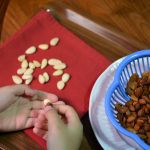
- Repeat the process until all almonds have been blanched and peeled. Spread the peeled almonds in a single layer on a towel-lined tray and leave to dry thoroughly (several hours or overnight) before proceeding.
Make and Shape the Almond Paste
- Divide the blanched almonds in half. You'll be frying half of the almonds and leaving the other half raw. The fried almonds add color, texture and flavor to the almond paste.
- Fry half of the blanched almonds. To fry the almonds, heat about 1/4" of vegetable oil in a deep skillet or large pot over medium heat. When the oil is hot, fry the almonds in batches, stirring constantly, until light to medium golden brown. Each batch should take about 5 minutes, providing the oil isn't to hot. Don't allow the almonds to get any darker, as they'll continue to color once removed from the oil.
- Transfer the fried almonds to a strainer or tray lined with paper towels and leave to cool.
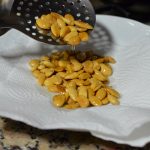
- Grind the cooled, fried almonds with the sugar. In a food processor, grind the fried almonds with about half of the sugar until the almonds turn into a thick paste. Transfer the almond paste to a bowl or onto a large tray.
- Grind the blanched raw almonds with sugar. Add the blanched almonds and remaining sugar to your processor and grind to a paste. Add this paste to the fried, ground almond paste.
- Mix the almond paste filling. Combine the almond paste mixture with the cinnamon, salt, mastic gum powder, softened butter and orange flower water. Use your hands to mix and knead the paste thoroughly for several minutes. Taste and adjust flavoring, adding a little more cinnamon or orange flower water as desired. The final mixture should be moist, pliable and easy to shape.
- Shape the almond paste into balls. Roll all of the almond paste into equal-sized balls. For the small 5 cm (1.75") briouats shown in the photo at the top of the page, the balls were made cherry-sized. You can make them larger if you want larger pastries.
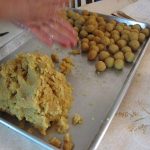
Fold the Briouats
- Cut your warqa pastry sheets into strips. For cherry-sized balls, use a 5x30cm (1.75x10-inch) strip of dough. Increase the measurements proportionate to the size balls you rolled.
- Spread the center of the strip with a little melted butter and place the almond paste filling near the bottom.
- Wrap up the bottom of the dough to enclose the filling, and shape the triangle by folding the filling – up to the right and then left – until you reach the end of the dough. Press the filling gently to fill out the triangle as you begin folding. Each time you fold, you'll be flipping the bottom corner of the triangle up to the opposite edge of the dough while maintaining a straight edge. Four or five flips of the triangle is sufficient as you don't want too many dough layers. Trim the excess dough to make a neat flap, dab a little egg yolk on the flap to help seal and tuck it into the fold.

Fry the Briouats and Soak in Honey
- Heat 1/2" of vegetable oil in a deep frying pan set over medium heat. At the same time, heat 1 kg of honey mixed with 1 tablespoon of orange flower water in a second pot. Remove the honey from the heat when it is quite hot and becomes slightly foamy on top. Set up a heat-proof strainer over a bowl.
- Fry the briouats in batches in the hot oil, turning several times and moving them around in the oil, until light golden brown. This usually takes about 5 to 7 minutes. With a slotted spoon, transfer the fried pastries directly from the oil to the hot honey.
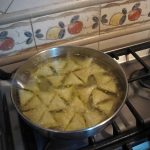
- Begin frying the second batch of almond briouats while the first batch is soaking in the honey. Occasionally submerge the soaking briouats in the honey by pushing down on them gently. Transfer the honey-soaked briouats to your strainer when the second batch of briouats is nearly ready to be removed from the oil. Optional: At this point, you can garnish the hot, honey-coated briouats with a sprinkle of sesame seeds.
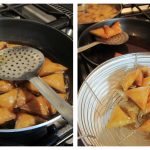
- Note: The volume of honey will decrease as it's absorbed by subsequent batches of pastries. As that happens, you won't be able to submerge the pastries so you'll need to turn them over several times to ensure that they're well-coated with honey, or you may prefer to add more honey to the pot. Reheat the honey if it cools as you want it to remain hot and thin.
Cool and store the briouats.
- When the next batch of briouats is ready to be moved from the honey to the strainer, transfer the ones which have been draining to a platter or tray to finish cooling. It's fine to stack them at this point. Leave them for an hour or longer to cool thoroughly before storing.

- The briouats can be kept in a tightly sealed container at room temperature for a month, or in the freezer for several months. If storing in the freezer, place a sheet of plastic wrap between layers to make it easy to remove only as many cookies as you need.
Notes
- Warqa pastry, also referred to as brik or brick pastry, is paper-thin and unique to Morocco and North Africa. You might find it sold in halal or Middle Eastern markets.
- A double layer of fillo dough will work as a substitute for warqa—select extra thick "country style" or "horiatiko"—but it is more fragile and flakier than warqa.
- Flour-based spring roll wrappers may also be used in place of warqa. (Do not confuse these with stiff rice paper wrappers.) They are a little thicker and so fewer folds of the triangle are needed. They seal with just a dab of water.
- To crush mastic gum grains, place them in a small bowl with 1/4 teaspoon granulated sugar. Use the back of a spoon to crush the grains to a fine powder. (The sugar prevents clumping.)
- Be sure that the honey stays hot and thin while soaking the almond briouats, otherwise the pastries will be coated too heavily.
Serving: 1briouat | Calories: 137kcal | Carbohydrates: 16g | Protein: 2g | Fat: 7g | Saturated Fat: 1g | Cholesterol: 3mg | Sodium: 51mg | Potassium: 81mg | Fiber: 1g | Sugar: 9g | Vitamin A: 45IU | Calcium: 28mg | Iron: 0.7mg
Nutrition information is provided as a courtesy and is only an estimate obtained from online calculators. Optional ingredients may not be included in the nutritional information.
Did you try this recipe? We'd love to know!Mention @tasteofmaroc or tag #tasteofmaroc!